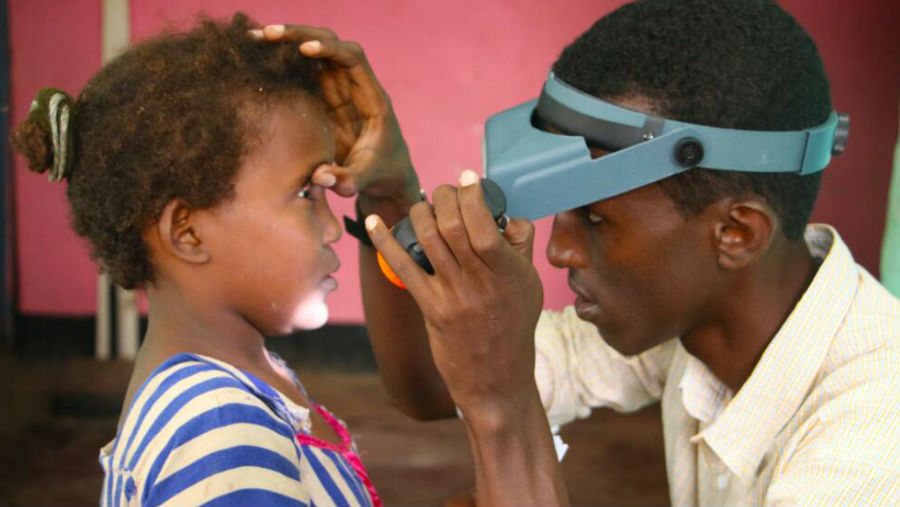Join a powerful, unprecedented alliance for better eye health for all.
Join IAPB-
Choose an alternate language here

Universal Health Coverage (UHC) has been gaining increasing support in recent years. Successive World Health Organization Director Generals have made UHC a priority and it was formally recognized in the Sustainable Development Goal 3.8, which calls for “achievement of universal health coverage, including financial risk protection, access to quality essential health-care services and access to safe, effective, quality and affordable essential medicines and vaccines for all.”
The path to achieving UHC, however, is multi-faceted and complex. In many countries, diseases with large burdens, such as trachoma – the world’s leading infectious cause of blindness, cannot be properly managed by existing health care systems and require interventions to be delivered through context-specific programmes. But what is the relationship between health programmes and UHC and how can disease programmes accelerate progress to achieve it?
The global trachoma elimination programme is a strong example of how a disease programme can support the achievement of UHC. The programme’s SAFE Strategy (provision of surgeries and antibiotics, improved facial cleanliness practices and environmental conditions) provides a wide range of essential health services, without imposing economic hardship to those it serves. From health education to treatment, strengthening data collection and analysis, improving supply chain management and ensuring high-quality surgical outcomes, the programme is reducing the disease burden and is strengthening the capacity in endemic countries.
The programme includes innovative initiatives, such as HEADSTART, a training tool that is allowing surgeons to practice surgery techniques on a life-like surgical simulator. It provides a valuable addition to live surgery training for surgeons, who once practiced on orange rinds and is building the confidence and skill sets of surgeons around the world.
Other tools include the Zithromax® Shipment Tracker, developed by the International Trachoma Initiative, which provides real-time data for drug shipments. This helps national programmes to effectively plan drug distributions and make adjustments when delays occur. The tracker improves communications between national programmes and partners, which in turn helps to ensure drugs are delivered where and when they are needed.
The effective provision of surgery and mass drug administration are essential to reduce the burden of trachoma to a level that is manageable by health systems and the programme is already seeing significant results. Increased government buy-in and scale up in recent years has contributed to significant outcomes. From 2011 – 2016 the number of people at risk of trachoma reduced from 325 million to 182 million. Furthermore, a record breaking 260,000 surgeries and 85 million people received treatment in 2016, many of whom live in the most remote and hard to reach areas without access to formal health services.
By working closely with Ministry’s of Health, the programme is also building capacity in data collection and analysis. Ensuring governments have robust data to inform their decision making is an inextricable component of the global programme and from 2012 – 2016, partners conducted the world’s largest ever infectious disease survey, the Global Trachoma Mapping Project. The project collected information from 2.6 million people in 29 countries to accurately identify the trachoma burden in districts suspected to be at risk.
The project, funded by the UK Department for International Development and USAID, used smartphone technology to provide governments with robust standardized data, which is informing the design of national programmes. This technology is now being used through the Tropical Data Initiative, which supports the full survey process, from planning and protocol development through to data management and analysis of the data.
Universal health coverage is not only about treating people who are sick, but also requires that infrastructure is in place that prevents people from falling ill in the first place. The F&E components of the SAFE Strategy (namely facial cleanliness and environmental improvements), are essential to the sustainability of the programme as they reduce the transmission of the disease. These water, sanitation and hygiene (WASH) programmes are being increasingly integrated into national programmes, reducing the risk not only of trachoma, but also diarrhoea, cholera, dysentry and other neglected tropical diseases including schistosomiasis, lymphatic filariasis and soil-transmitted helminths.
The achievement of UHC cannot happen overnight. Many health systems require strengthening so that they can reach all people with the interventions they need. The global trachoma elimination programme can reach communities with interventions where the existing health system currently cannot, making it an important stepping stone on the path to UHC. Delivering quality health care and achieving UHC must happen incrementally and pragmatically, but by working together with this goal in mind we can advance and accelerate this progress and achieve our goals.
Photo courtesy: Mohamed Ahmed Omar for #MakeVisionCount photo competition